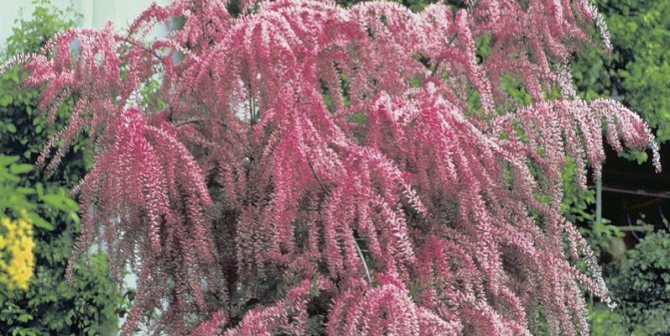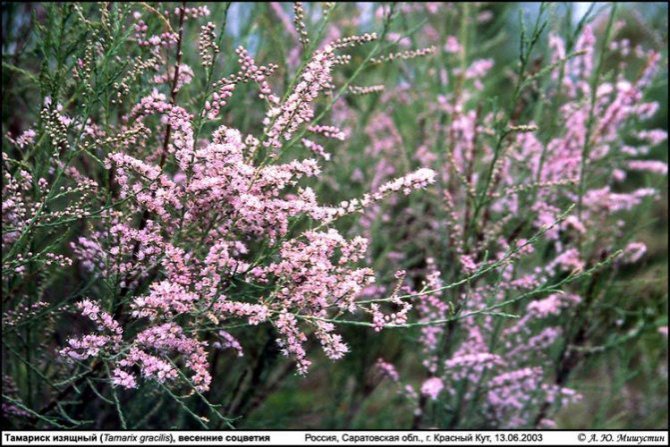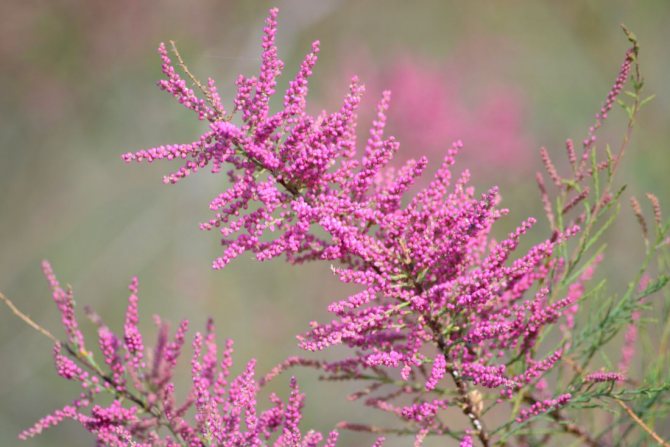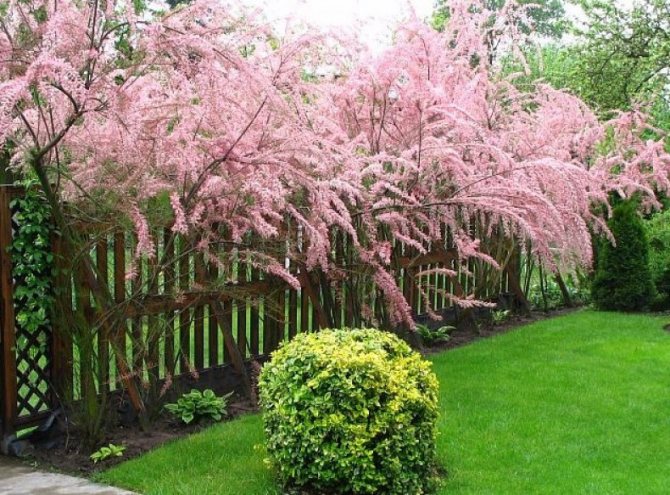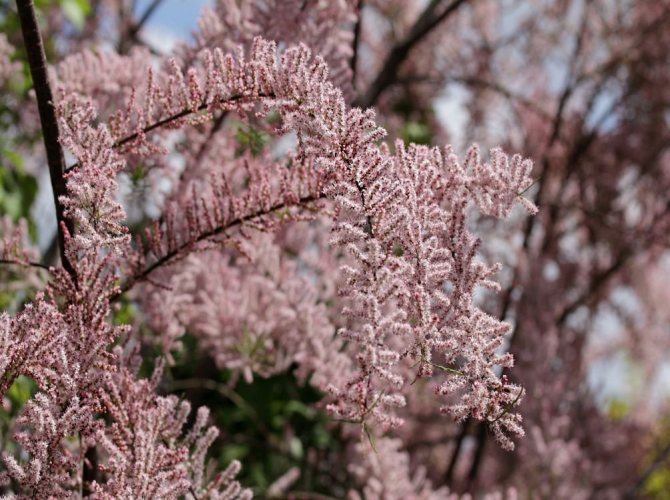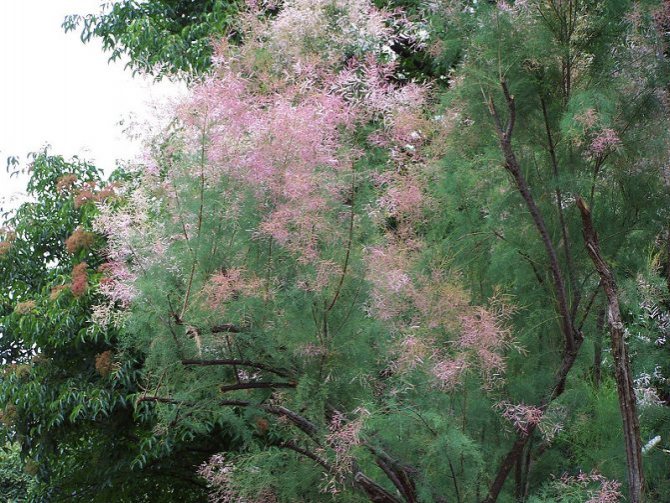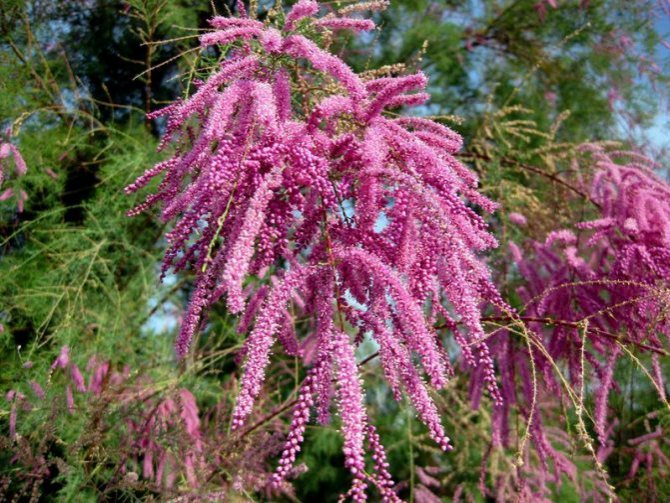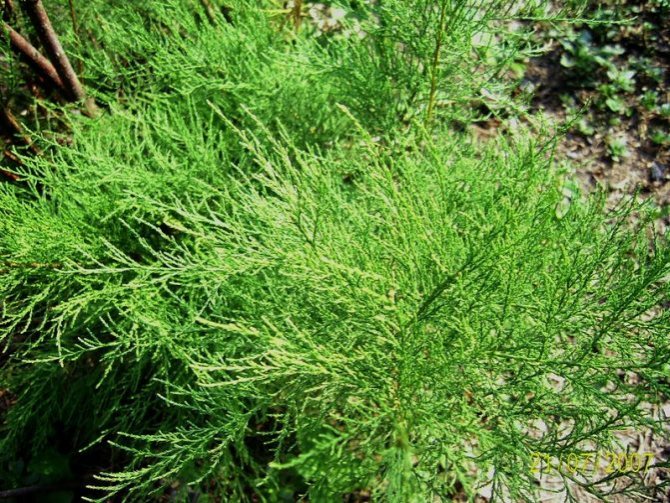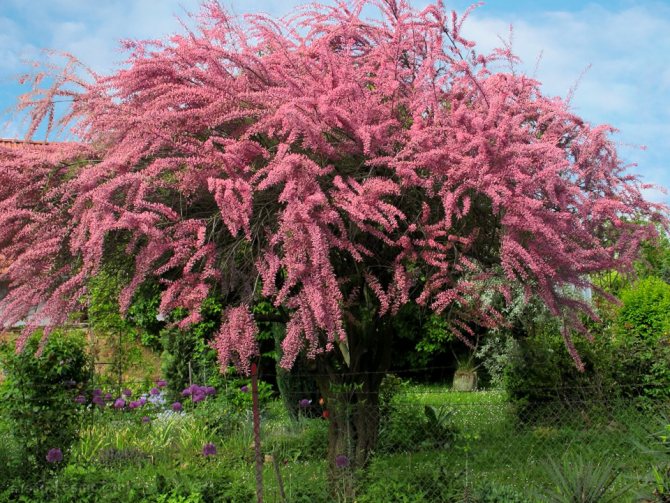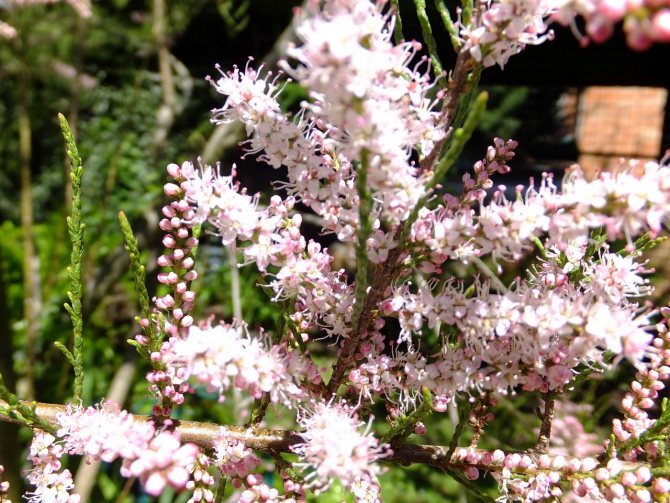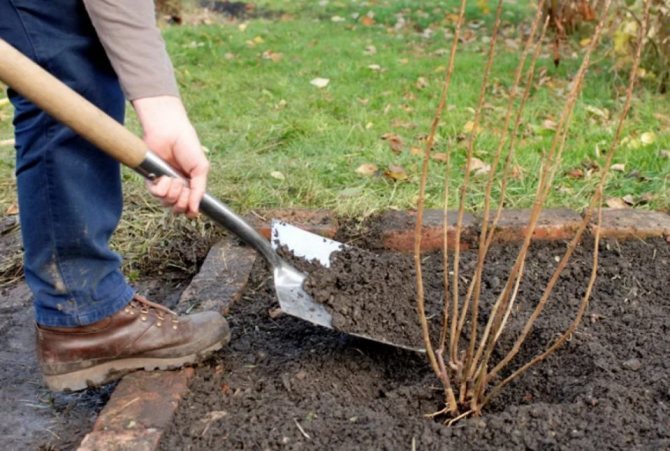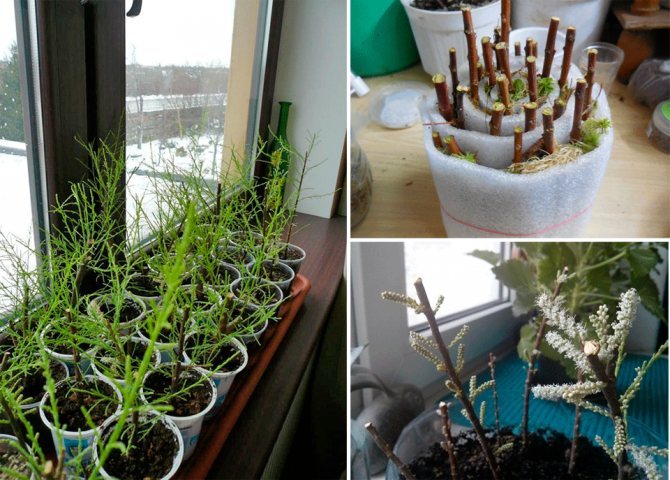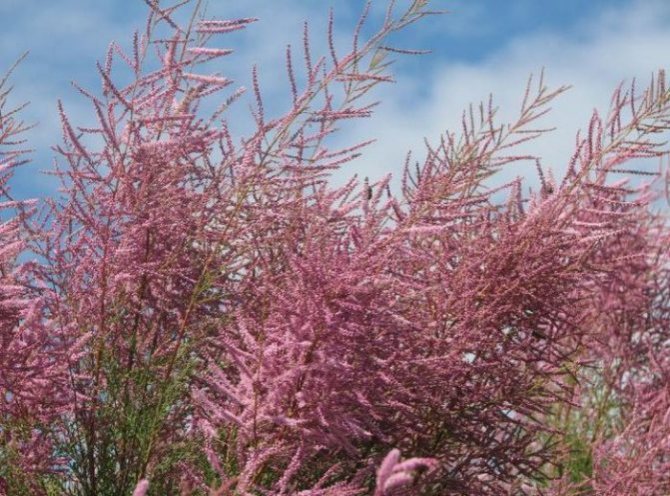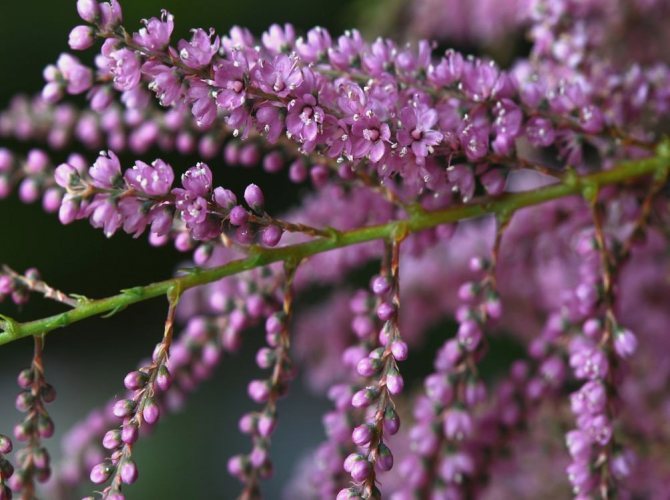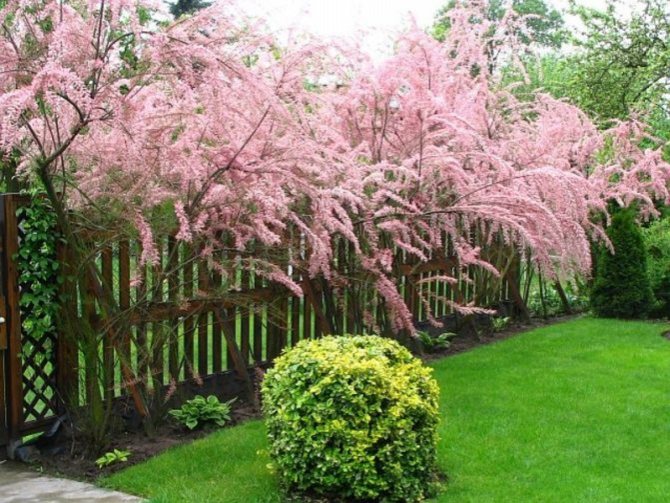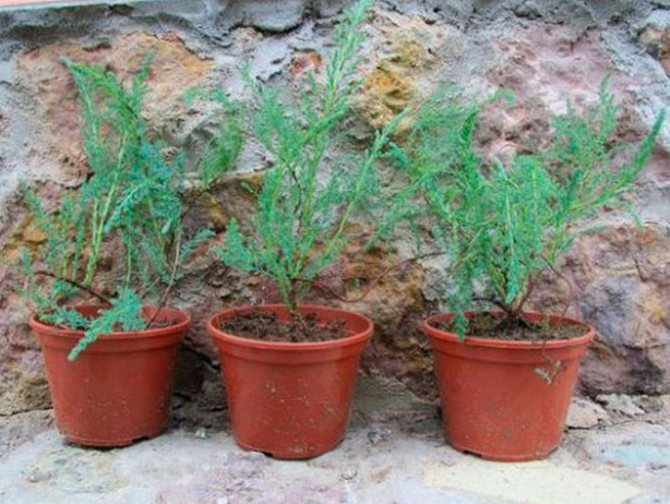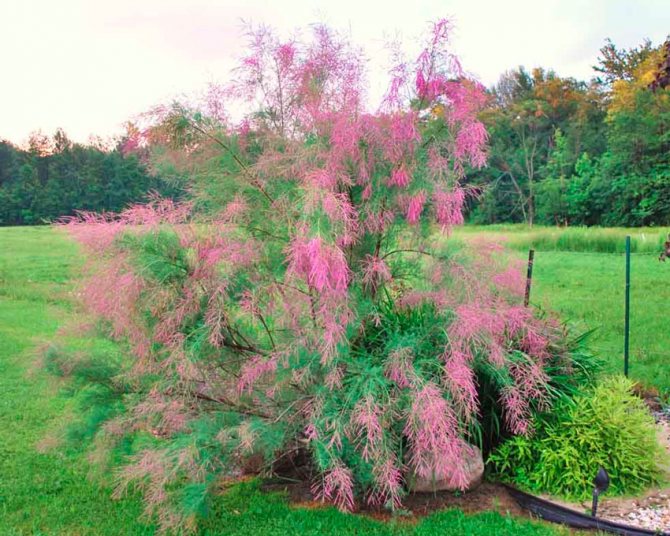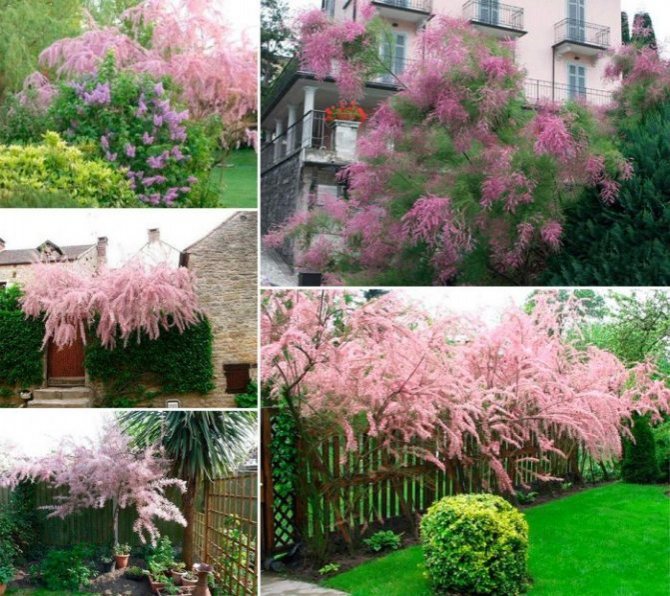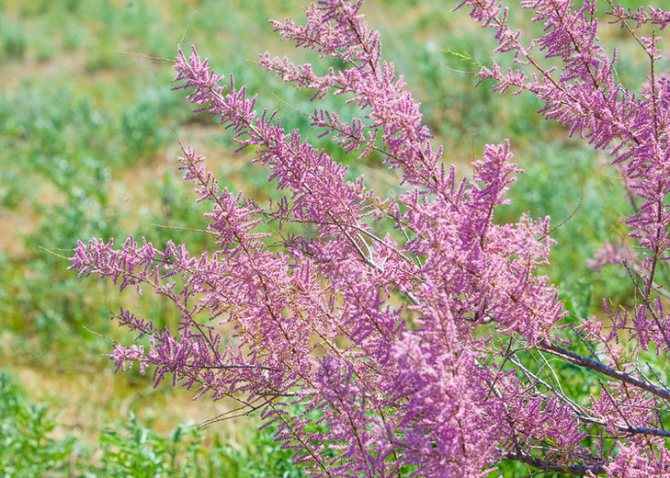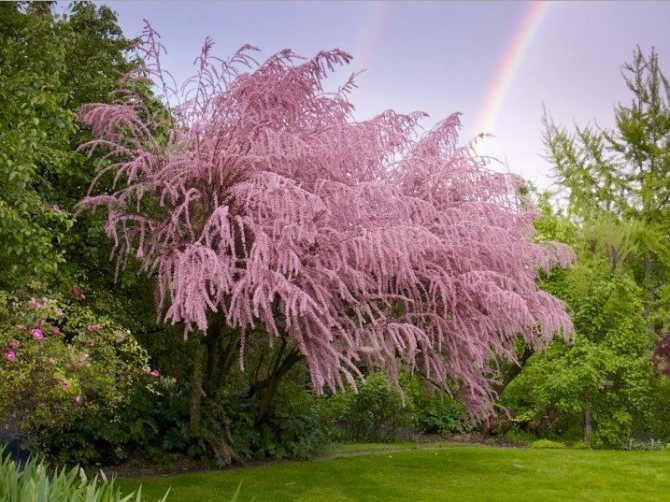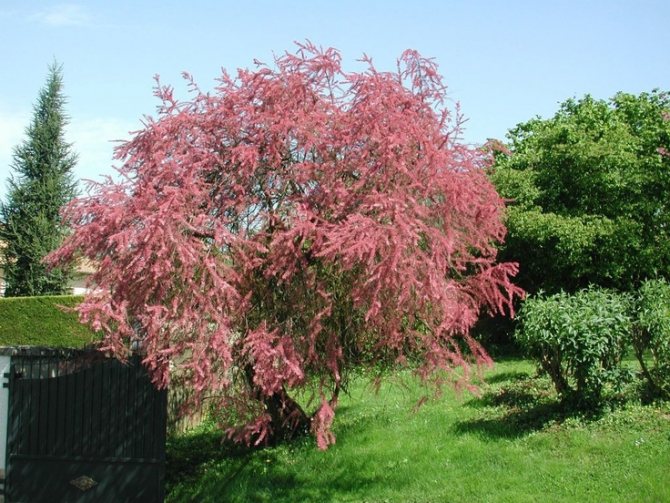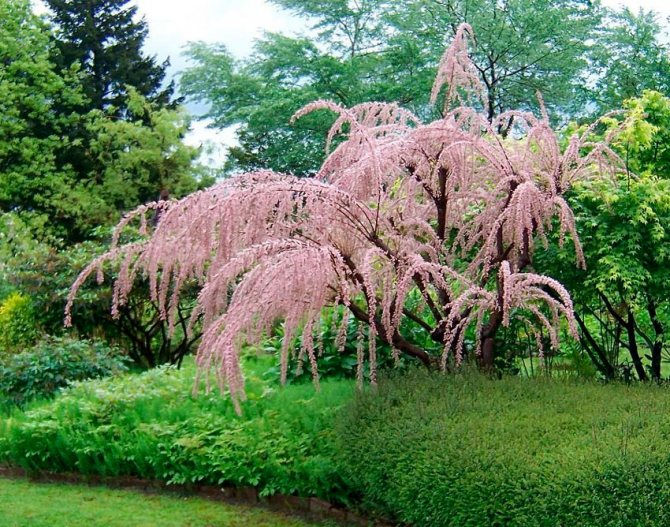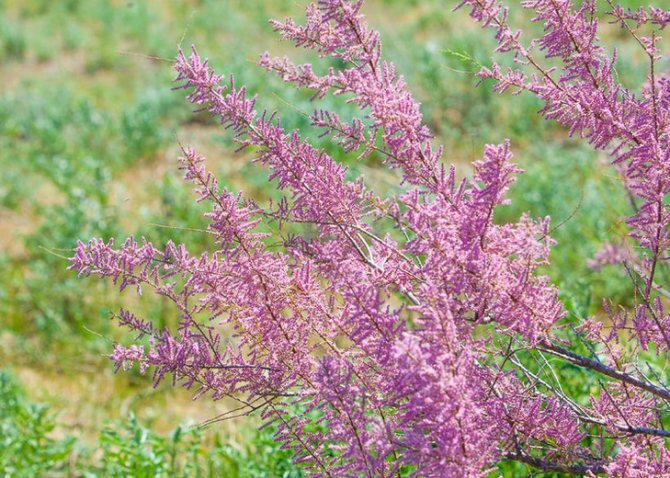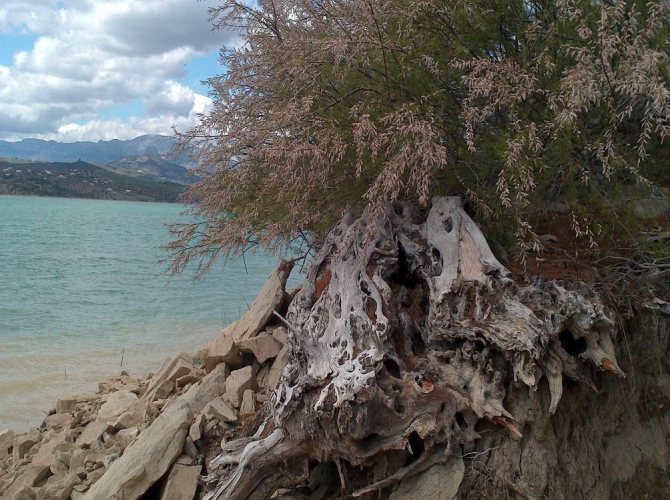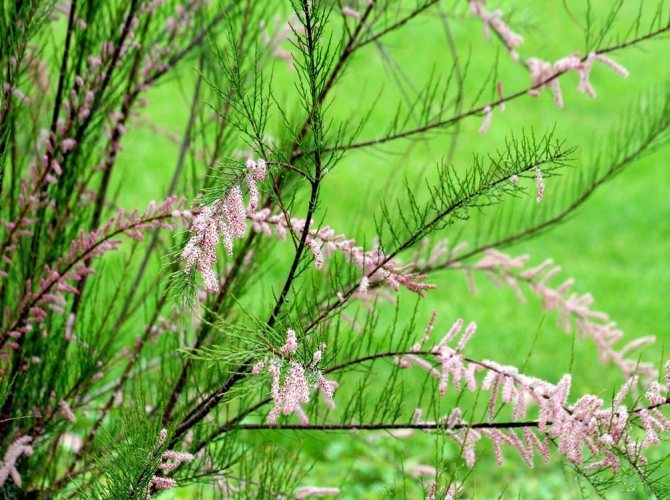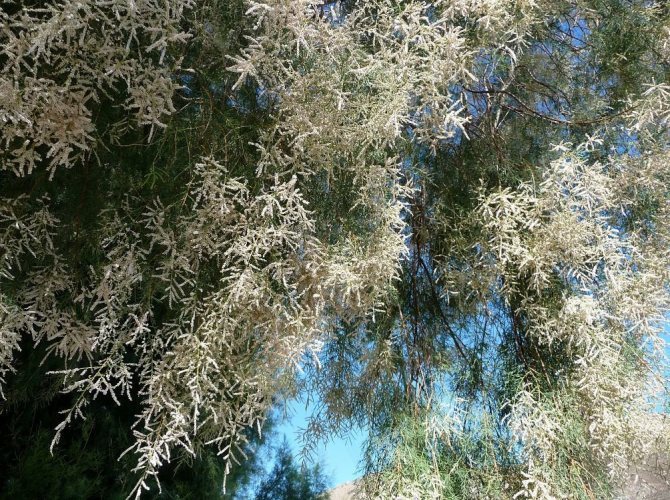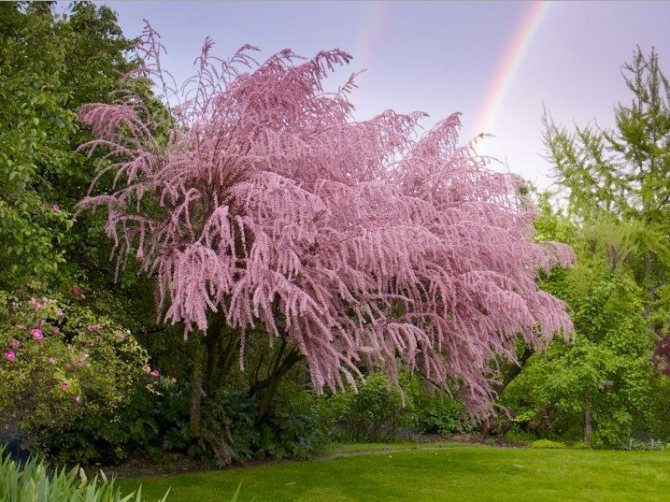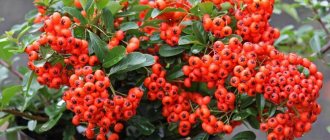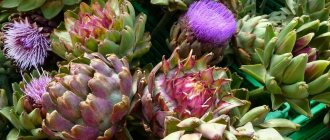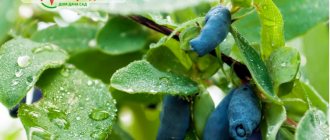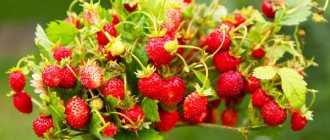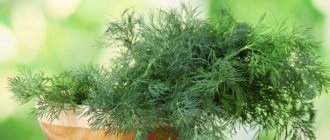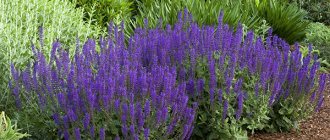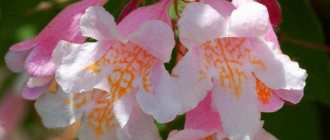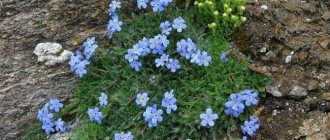Tamarix, perhaps like no other plant, claims to be the most unkillable plant - an ideal option for a low-maintenance garden. But the decorative effect of a tamarix bush, preparing for flowering or already blooming, is so impressive that it is difficult to admit the thought of such unpretentiousness of the plant. Incredibly thin openwork canvases made of beads - this is the impression that a bush covered with buds leaves. These associations awarded the tamarix plant with a second name: the people call it that - bead.
Description of the plant
Tamarix is a small perennial bush or tree that belongs to the Tamarisk family. Culture grows practically everywhere, while in many countries it has its own popular name. Most often, tamarisk is called a comb, tamarisk, bead. The names determine the appearance of the crop that tamarix takes on during flowering. Based on the species, beads with evergreen leaves are often found, less often deciduous species.
The plant is a low culture, growing in the form of a tree or a lush bush, not exceeding 5 m upward. In diameter, the trunk of a tree rarely reaches half a meter. The peculiarity of the plant is the formation of a crown, which consists of small twigs and stems, as well as rough shoots.
The roots of the comber are sprawling long roots, some of which are located under the top layer of the soil, and the other part goes into the soil. 1 trunk or several branches forming a crown departs from the base of the root collar. The trunk of the tree begins to branch out at a distance of about half a meter from the ground. Shrubs form lateral branches almost at the very base of the soil. The comb grower forms a luxurious crown, consisting of many lateral branches and shoots, which are covered with dark green foliage.
All branches and shoots are completely covered with alternate leaves that have a needle-like structure. The leaves are very small, no more than 5 mm in length. The adult plant is completely covered with scaly leaves that fit tightly to the branch. There are varieties that form foliage of an emerald, bluish hue. There are no stipules on this plant. On the surface of the foliage, you can find small depressions, which are glands for the release of salts.
Most species of tamarix bloom with bisexual flowers, and only one species is dioecious. Inflorescences are very small, no more than half a centimeter in size. Inflorescences are formed on twigs, completely cover the shoots and twigs, forming a dense brush or panicle. The flowers in the inflorescence have 4-5 petals, the flowers are round, ovoid in shape. The culture blooms with purple or purple flowers. There are varieties with white or red shades of buds. The unopened buds of tamarix are compared with beads strewn on the surface of the shoots. During the flowering period, the whole culture becomes the same shade, due to the density and abundance of inflorescences. Different varieties of comb bloom at different times. Early varieties bloom in May, later ones in mid-summer.
After flowering, fruits are formed on the shoots - achenes, inside which small straight seeds are located.The seed is about half a centimeter long. After ripening, the capsules open, and the seeds are carried away by the wind to various places. The seeds are not highly durable.
Tamarix shrub - description
Tamarics are graceful deciduous or evergreen shrubs. Often among them there are bushy trees growing from 1.5 to 12 m in height with a trunk thickness of up to 50 cm.The crown of a tamarix is formed by twig-like shoots, densely covered with successive miniature leaves of a bluish-green, emerald or dark green shade similar to scales. Small pink or white tamarix flowers form large clusters or panicles. Before the flowers open, the bud-covered plant looks like it has been strewn with beads. During the flowering period, tamarix attracts bees, as it is an excellent honey plant. Tamarix fruit is a pentahedral-pyramidal polyspermous capsule with small seeds.
The tamarix plant is distinguished by drought resistance and extraordinary vitality. It perfectly adapts to gas pollution in large cities, and planting and caring for tamarisk will not cause trouble even for a lazy gardener.
Spread
The culture is found mainly in desert areas. Wild varieties of tamarisk live on salt marshes and in the steppe zone. The plant prefers arid regions of the European part of the continent, as well as Asia and Africa. The optimal habitat for the comb is considered to be a subtropical and tropical climate. Certain varieties grow as wild representatives of South America and Northern Australia.
Tamarix is highly resistant to cold, so it easily takes root in any area, including climatic conditions where the air temperature in winter drops to 50 degrees below zero. The plant is distinguished by its unpretentiousness to the composition of the soil, therefore it is cultivated in an area with a high salt content in the substrate, sandstones and in areas with high acidity.
In our country, beads are often cultivated as a decorative culture. The plant easily takes root in gardens, and is also cultivated at home, does not require much effort in the care. You can meet the plant as a decoration for gardens and parks, adjoining territories.
Tamarix - species
There are more than 70 varieties of tamarix in the world, but only a few grow on the territory of the CIS:
- The branchy type is characterized by a small height (2 m), vertical growth of long branches. The leaves are bent down, the flowering period is June-September. A distinctive feature is moisture resistance, therefore it is found on the banks of rivers.
- Four-point - grows up to 10 m, the shape of the branches is arched, the foliage is rich green. It begins to bloom before everyone else - in April-May.
- The loose variety (dioecious) is characterized by a height of 5 m, oval leaves, delicate pink inflorescences, collected in a bunch. Blooms from June to August.
- Hohenaker is decorated with white or pink petals with a lilac tint. The height of the shrub is 2-3 m.
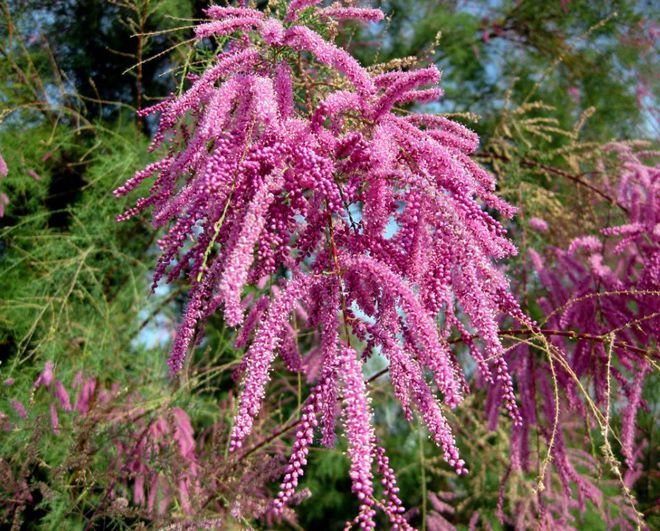
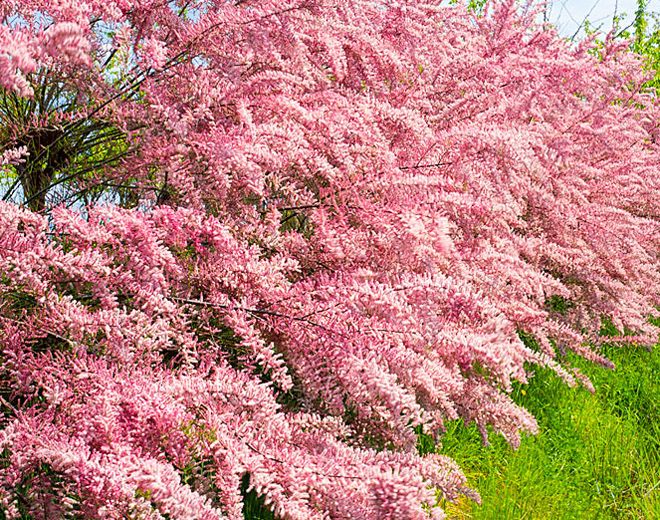

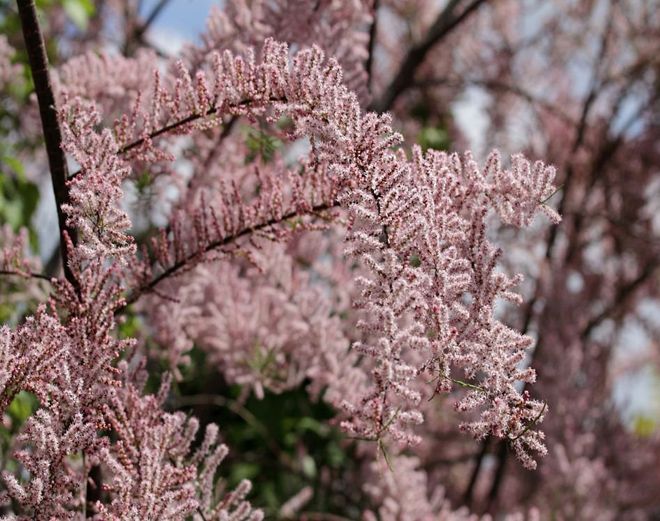

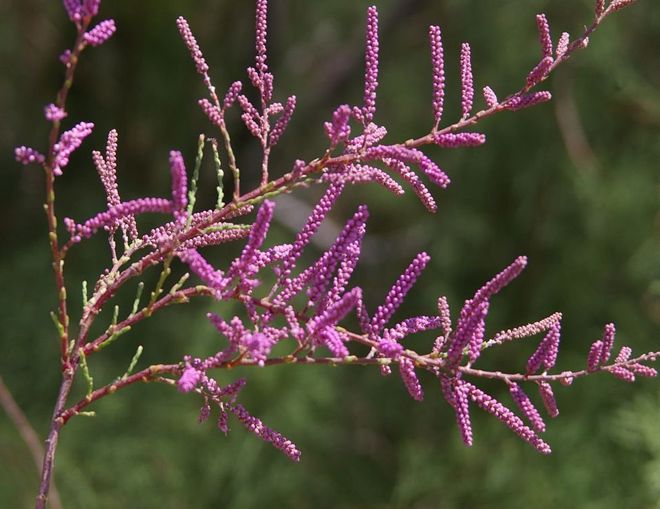

Views
The Tamarisk family has more than 70 species of culture, growing in the form of low bushes or trees. In our country, only a few varieties are cultivated, which are distinguished by good resistance to cold weather and unpretentiousness to planting conditions.
Branched tamarixramosissima
Bushes growing up to 2-3 meters, with a vertical, straight crown. The main branches are abundantly covered with many straight, thin and long branches, densely covered with scales. At the ends of the branches, young shoots of a greenish color are formed annually. Young shoots are distinguished by small leaves of a needle-like structure, only a few millimeters long. Scaly leaves practically envelop the entire surface of the stems and twigs and make the brown shoots completely green.
The comb bloom occurs at the beginning of summer.Large pink inflorescences form cyst-like twigs, completely covering the peduncles with pink small inflorescences. The brushes reach 5 cm in diameter, they consist of many pink flowers, which retain their decorative effect throughout the summer. During the flowering period, the shrub becomes almost completely pink, due to the abundance of buds.
Branched tamarix has a number of varieties that differ in shades of flowers:
- Rubra is a comb variety that blooms with many purple paniculate inflorescences;
- Pink Cascade - the culture is a small bush on which small light pink flowers are formed in summer;
- Summer Glow is a Tamarix hybrid that blooms with raspberry bunches.
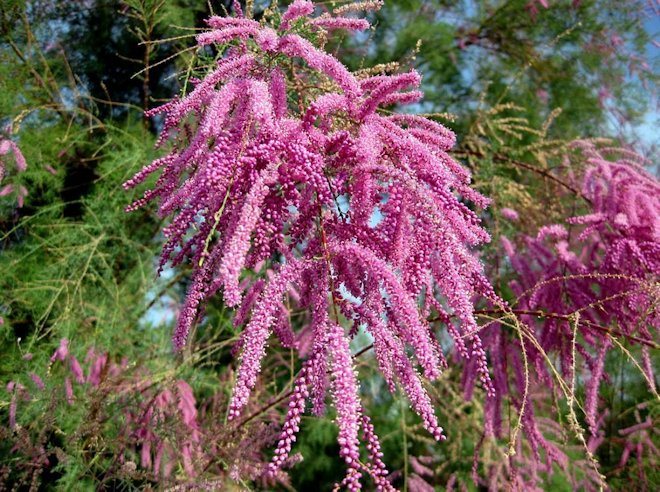

Graceful tamarix gracilis
A relatively large bush, the size of which can reach 4 meters up. The plant has dense, brown stems that branch strongly into drooping stems. The surface of the stems is covered with a thin layer of burgundy-brown bark, with small spots on the surface.
On the entire surface of shoots and young twigs, the plant is covered with small green scales, the sizes of which vary: on young shoots, the leaves are small, only 2-3 mm long. Older branches are covered with scales, often more than 5 mm in diameter.
The culture blooms with a bright pink inflorescence, in the form of a brush. Flowers appear in May, but the culture reaches a high decorative effect in April, when all the branches are covered with small buds that look like beads are scattered on the surface of the branches.
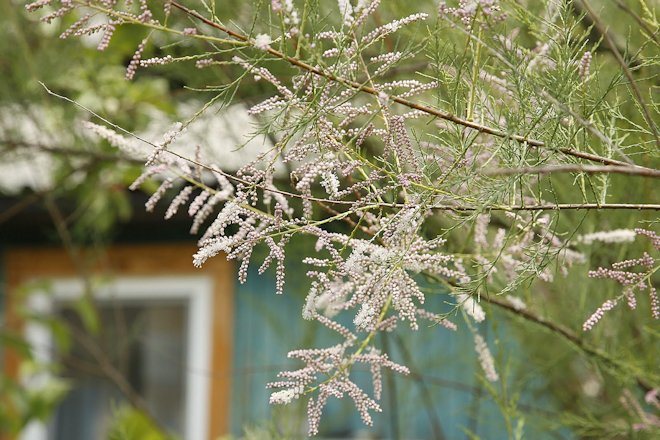

Meyer tamarix meyeri
Perennial with bright graceful forms, forming a sprawling bush. The culture is characterized by rapid growth, which slows down only after reaching the mature age of the culture. Wild representatives of this variety are found almost everywhere. The culture is widespread in Transcaucasia, Iran, Central Asia and Dagestan. In our country, the comber lives in the Astrakhan region and Stavropol. Some individuals form small thickets in the Rostov region.
Small trees that grow up to 4 meters high. Differs in dense thick stems and branches, on the surface of which there is a reddish bark. The main branches branch profusely with adventitious shoots, on which there are green scaly leaf plates. The leaves practically envelop the stem due to their curved shape. Inflorescences in the form of brushes appear on young shoots formed last year in the spring. The flowers are pink, rarely white.
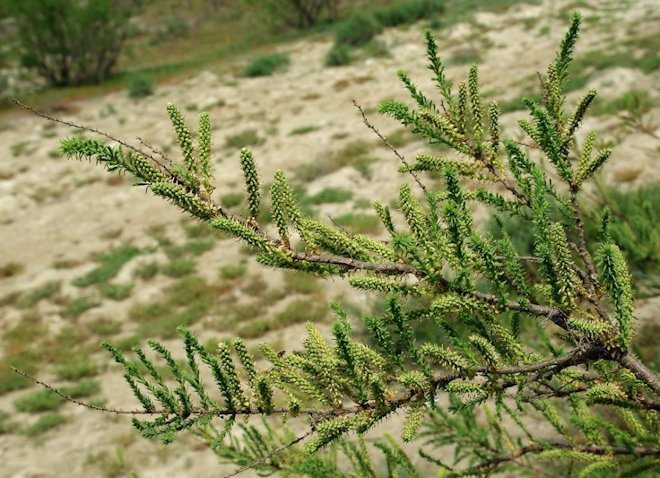

Loose tamarix laxa willd
A culture that lives in the North and in the western part of the Caucasus. Some varieties grow in Iran and Mongolia. It is a perennial evergreen shrub or tree, reaching up to 5 meters. Young shoots appear on the surface of old stems, which are covered with light green needle-shaped foliage. The variety blooms with pink buds, when loose, reaching 5 mm in diameter. Inflorescences are located on the tops of the shoots, retain their decorative effect for 2 months.
The branches of the variety are bare, dark green or bluish in color, due to the dense arrangement of scales on the surface. The leaves are rounded in shape, slightly narrowed upwards. The crop is evergreen, it grows well in cold conditions and in saline soils.
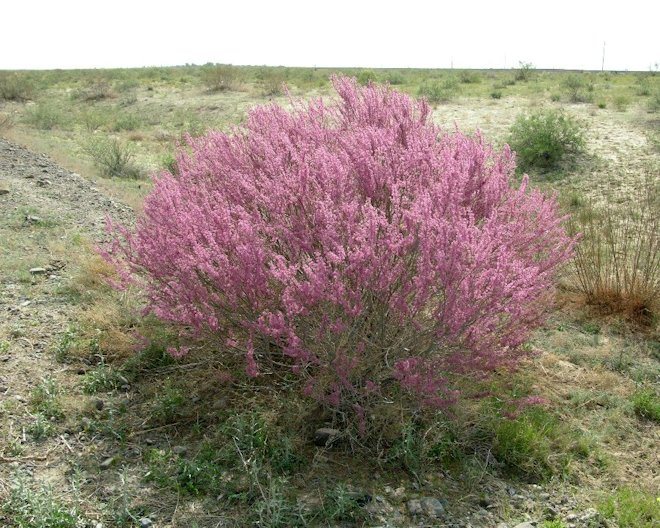

Dioecious tamarix dioica
The plant is distinguished by its small forms. Shrub up to 4 meters high, with dark green leafy shoots. It differs in the appearance on the culture of both female and male flowers, which are necessary for the comb-taker for reproduction and pollination. The shrub blooms in mid-summer. Inflorescences cover the crop abundantly, giving it a purple or bright pink color.
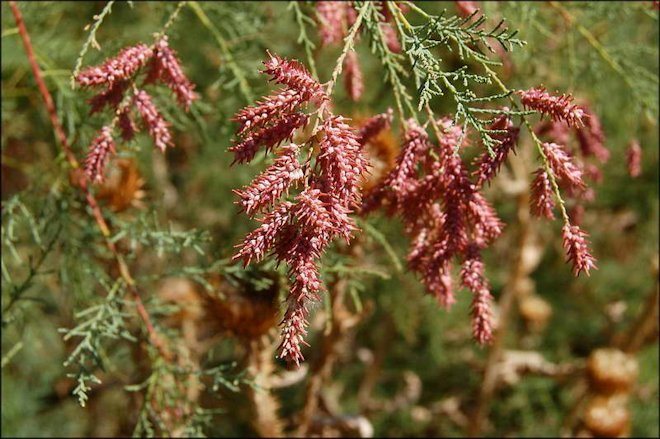

Four-pointed tamarixtetrandra
Tall bushes of tamariks, which grow up more than 5 meters. Individual trees can grow up to 7 meters or more. In Russia, it is found as a cultivated and wild plant, mainly in the Crimea and Astrakhan. The trunk of the tree is covered with stems curved outward, strongly branching at the top.
Leaves are located on the surface of the stems. The leaf plates are rounded, with a pointed end. Leaves are sessile, Emerald shade, narrowed towards the base. In spring, brushes appear on young shoots - inflorescences with a varied shade of inflorescences, from white to light pink. Flowering begins in late April or early May and lasts for 8 weeks. Under normal conditions, the culture can grow for up to 70 years.
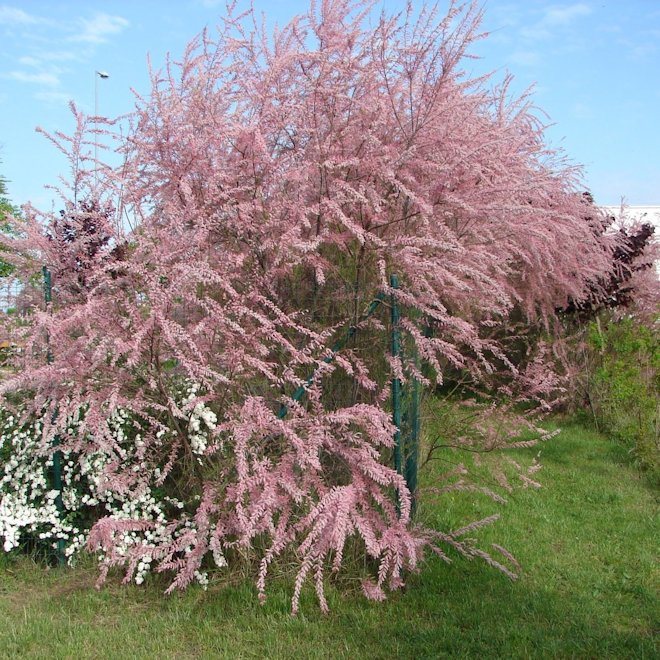

Types and varieties of tamarix
For cultivation on the territory of Russia, those species are chosen that are able to withstand low temperatures, since in natural conditions tamarix is a rather thermophilic plant.


Branched tamarix, which, due to its structural features, is called five-chained, is presented by breeders in three popular varieties:
- With red-purple flowers - Rubra;
- Thick light pink clusters of inflorescences - Pink Cascade;
- Violet-raspberry intense shades - Summer Glow
The graceful and four-stalked tamariks, although declared as winter-hardy, can freeze out even in the southern regions of Russia in snowless winters, so the shoots are wrapped in non-woven cloth, tied, laid and sheltered from the cold. But here, too, the simplicity of the conditions of detention is surprising: tamarix, beaten by the frost, but surviving after the winter, is able to recover in one season.
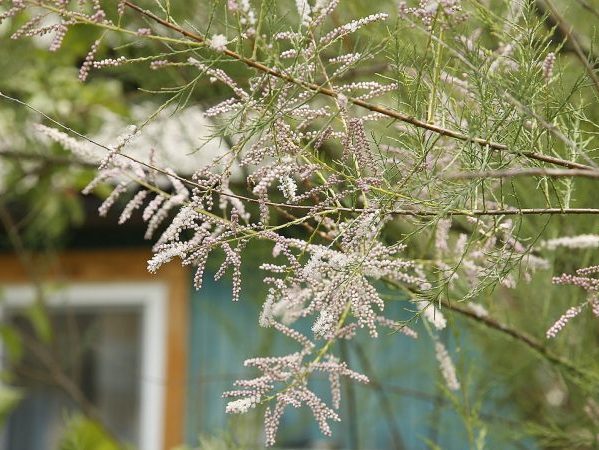

Tamarix graceful
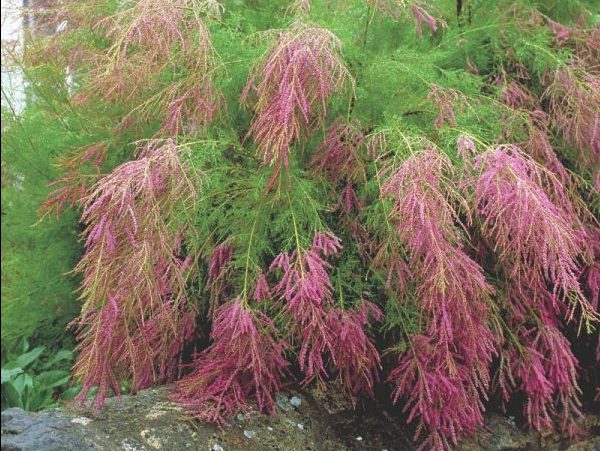

Tamarix branching Rubra
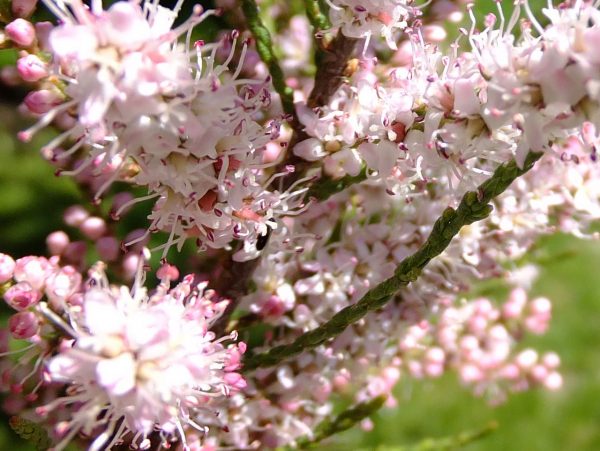

Tamarix four-stalked
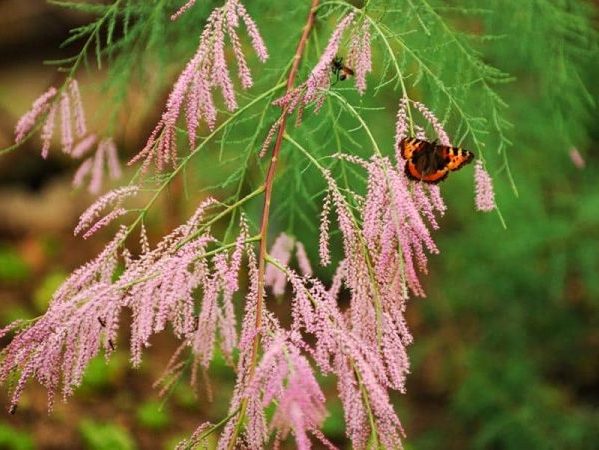

Tamarix Meyer
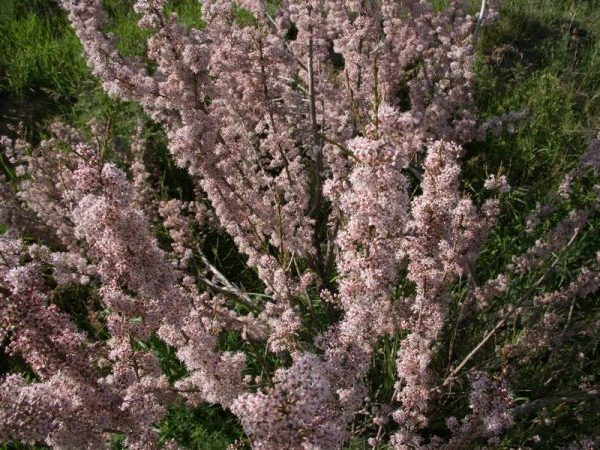

Loose tamarix
Planting tamarix in open ground
Tamarix is often seen as the cultural representative of gardens and parks. Despite the unpretentiousness of the culture to the living conditions, it is necessary to plant the plant correctly and provide it with high-quality care.
How to choose a seedling
To plant a comb, you must first choose the right live and healthy seedling in the nursery. When buying a plant, pay attention to a crop variety that must have good resistance to the climate in which it will be cultivated. Seedlings of beads should not be without a pot. The culture does not tolerate the openness of the roots for a long time, therefore, healthy tamarixes are always in stores with a closed rhizome. The outer surface of the seedling should not be damaged. In addition, buds and small leaves should be visible on healthy seedlings.
When choosing a seedling, it is important to understand that tamarix takes root well in the ground if the culture is less than 3 years old. Older cultures do not undergo change and transplantation well.
What time to plant
The optimal planting time is mid-spring. The culture takes root well in the ground if the air temperature warms up to 10-15 degrees. Some gardeners, on the contrary, recommend planting a perennial before winter, when active leaf fall begins.
Seat selection
You can grow a plant anywhere. The comber easily tolerates shady places. However, it is best cultivated in full sun or partial shade. The choice of the site should be approached very competently, having considered the landing site in advance. It is important to understand that after being placed in a substrate, the plant quickly develops a branched rhizome that is easily damaged. It is better to choose an open place where the tamarix will actively grow, without the need for a transplant.
Soil preparation
Before placing a seedling of beads in the open ground, it is necessary to carefully prepare the substrate. The soil in the cultivation area of the comb should not be heavy or clayey.Despite the fact that adults can withstand any soil composition, young seedlings actively develop in light, well-drained soil. The composition of the soil must contain organic fertilizers, peat and humus.
Before planting tamarix, the soil is dug twice at the cultivation site. The first loosening of the soil is carried out about six months before the intended placement of the seedling in the ground. During digging, the substrate is mixed with organic matter, sand and peat. For six months, the soil is saturated with humus and nutrients. The second loosening is carried out immediately before planting the plant. Immediately prepare the landing pit. Since the seedlings do not tolerate the presence of roots in the open air, the planting hole must be prepared in advance.
How to plant correctly
The size of the planting pit for small bushes should be approximately 60 cm in depth, width and length. The planting of the comb is carried out as follows:
- at the bottom of the planting pit, a drainage layer is preliminarily laid, composed of pebbles or foam, chopped bricks or crushed stone. In order for the comber to grow well, the thickness of the drainage should not be less than 20 cm;
- the drainage layer is covered with a thick layer of nutrient substrate and organic matter, then a layer of sandstone. As a result, a small hole should remain, about 20 cm deep;
- before placing the seedlings in the soil, they carry out the obligatory pruning of the stems of the bush. The plant is cut to a size of 30 cm;
- ready-made seedlings are placed in the planting pit, carefully distributing the rhizome on the surface of the upper layer;
- the rhizome is buried in soil, so that the soil is leveled with the root collar;
- the soil at the planting site is tamped and watered abundantly with clean warm water.
In the first season, after placing young seedlings in the substrate, they are sheltered from the sun. Young leaves do not tolerate the heat of the sun, because the leaves are immediately burned and lose their strength. When several young bushes are placed in the ground, a distance of about 1.5-2 meters is left between the plants.
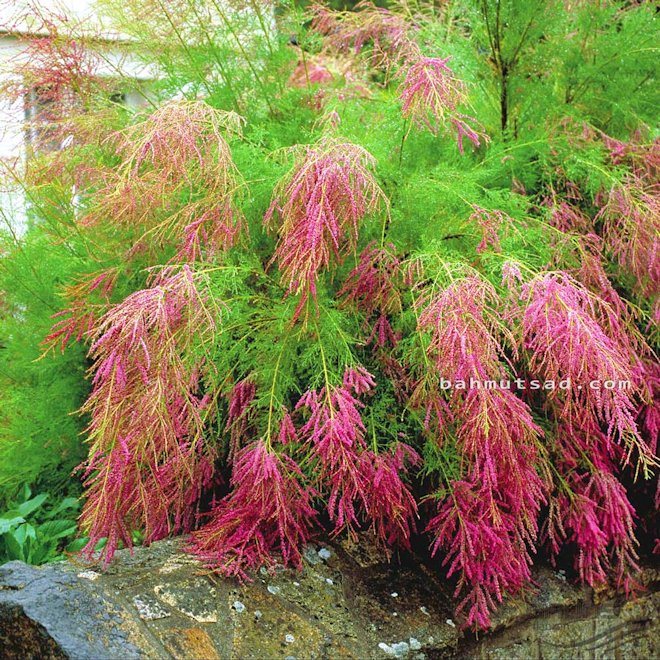

Features of the comber
There are about 75 species of this plant in the world, growing in a variety of conditions - from India to southern Europe. The flowering of the comb depends on the species and occurs in spring or summer. In general, it is an unpretentious, disease-resistant plant.
It has many thin, twig-like shoots covered with small, scale-like leaves of a delightful bluish or greenish hue. Small-flowered comb blooms from May to June, after which small leaves appear on drooping reddish shoots. The branchy comb blooms from July to September with beautiful pink flowers, collected in complex, dense clusters. It also has greenish or bluish branches. The Pink Cascade variety blooms especially luxuriantly.
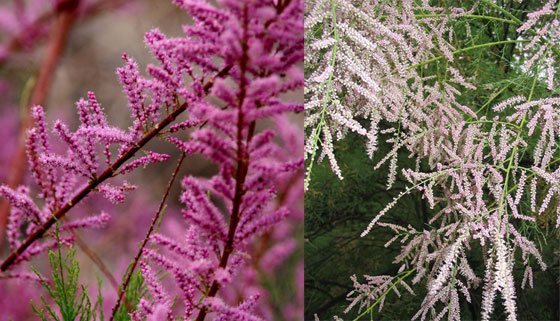

Growing a comb maker
A unified classification of plants of the Tamarix species, to which the comb belongs, still does not exist. Therefore, in order not to get confused, when choosing a plant, you should focus on the flowering time. And they have the same requirements for growing conditions.
Thanks to its colorful flowers and delicate greenery, the comb does not need obligatory partners. Single bushes can be grown on the lawn, in the front garden or by the terrace. It does an excellent job of being a hedge. With its help, you can easily mask ugly areas - paths with pebbles, dry slopes. Do not plant it next to shrubs with large leaves. Against their background, the small scales of the comb will not be so expressive.
It goes well with heather and steppe plants, other summer-flowering shrubs. Silvery and dark green conifers can be an excellent background.As neighbors, it is better to choose the same graceful and elegant plants that bloom at the same time or after the comb. Small-flowered comb goes well with spring spirea and broom.
Bulbous and ground cover perennials can be planted at the foot of mature plants. Summer-flowering - Perovskaya wormwood, Karyopteris Klandonensky, David's buddeley are ideal partners for a branchy comb. And in the background, conifers and red-leaved scumpia will look good.
Planting and leaving
Buy seedlings in containers in the spring or fall. Try to choose healthy, well-branched, compact plants. Do not buy too large seedlings or plants with bare roots, they do not take root well. Choose a sunny, warm place for planting. The soil should be loose, permeable, slightly calcareous.
Dig a planting hole to be twice the size of the root ball. Loosen the soil in the hole, and mix the excavated soil with compost. Before planting, water the seedling well and remove it from the container, straighten the roots. Pour fertilized soil at the bottom of the hole and place the plant in it. Fill the pit with improved soil and make a watering circle. Water the seedling and cover the root area with chopped bark and compost.
Prune in the spring or summer. But it should not be radical, since young shoots will not grow from hemp. The comb is a fairly drought-resistant plant, so he does not need excessive watering. Cover the plant with spruce branches for the winter. And in the spring you can propagate it with apical cuttings, they will take root very quickly in a mixture of sand and peat.
Related Articles
Egg without yolk omen
15.11.2019
Japanese fertilizer in bottles how to use
15.11.2019
Manger for hay for cows
15.11.2019
Boiled egg chemical composition
15.11.2019
Caring for tamarisk in the garden
After planting, the tamarix grows rapidly. During the active growing season, it is important to provide young bushes with proper care, which differs little from other garden plants. The seed bead needs regular watering, feeding and pruning.
Temperature
In the first year after cultivation, tamarix seedlings need shelter from the sun. Plants cannot withstand intense heat. The optimum temperature for the growing season of tamarix in the first season is 18-20 degrees. Grown crops tolerate drought quite easily. In summer, they feel fine at temperatures up to 30 degrees, and in winter, during the dormant period, varieties with good cold resistance can withstand up to 30 degrees of frost.
Air humidity
Tamarix is a lover of the arid environment. The culture does not require an abundance of moisture. The plant grows actively in desert places, under constant sunlight. The plant does not require additional spraying.
Watering
Tamarix needs regular and systematic watering. Watering is carried out as the top layer of the soil dries up. A bucket of water is introduced into the soil under the plant. Watering is carried out at least once every 2 weeks. During a drought, watering is increased. Adult crops practically do not need soil irrigation. If it rains regularly in summer, watering can be stopped altogether and carried out only in case of prolonged heat. In order for the soil to maintain the moisture level and not dry out, after watering, a layer of mulch of dry leaves or peat is created around the beads.
Transfer
Tamarix is very negative about the conditions of transplantation. Therefore, when planting a crop for the first time, it is important to choose a permanent habitat for the culture. If it is necessary to move the tamarix, preparation for the transplant is carried out in advance. In autumn, the soil is trimmed around the crop with a shovel, approximately at a distance of about 50 cm from the trunk. Thus, the roots will get used to the new conditions during the season.In the spring, they prepare a new place, dig a hole in advance and quickly transfer the culture to a new place, trying to preserve the earthen lump. After transplanting, the plant is watered.
Pruning
In the spring, tamarix is carried out formative and sanitary pruning. The plant grows rather quickly, therefore, the formation of even and decorative forms is required. April is considered an important condition for pruning, when juice production has not yet begun. When pruning, remove old branches to the ring.
Pruning can also be done in the fall. To preserve decorativeness, the culture is pruned strongly stretched over the season, as well as old inflorescences that have lost their decorative properties. After pruning, the plant will recover within a month after the procedure.
Bloom
Blooming of different types of tamarisk occurs at different times of summer. Most varieties start blooming in May, and some in July or early August. During the formation of buds and their blooming, the comb takes on an unusual decorative appearance. Due to the abundance of inflorescences, the culture becomes almost completely pink or purple. Decorativeness lasts for 7-8 weeks. The flowers are bright, dense, used mainly for garden decoration.
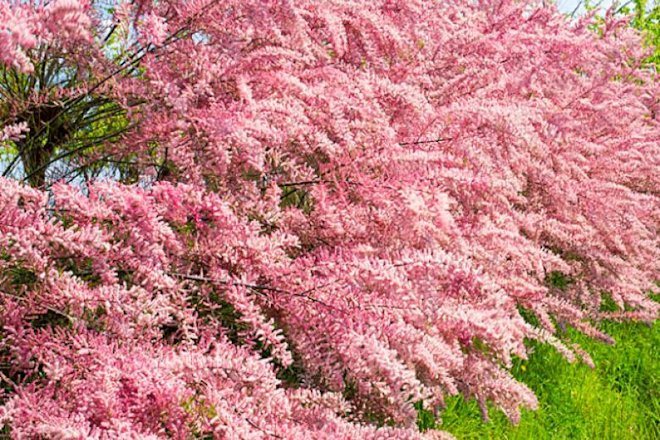

What a flower "tamarix"
Tamariks is a small tree-type shrub from the Tamariks family of the same name. It has thin arcuate branches with reddish-brown bark, it can reach a height of 4 m and more, but most often it grows only up to 1.5 m. In spring, tamarix shoots are covered with racemose inflorescences with flowers of white, pale pink and pale lilac. The leaves of tamarix are lanceolate, bluish-green, the crown is spreading and very light and delicate.
In total, there are more than 70 plant species, but in Russia, planting and caring for the four-stalked tamarix and several other varieties are most often considered.
Winter hardiness of tamarix
In general, the frost resistance of tamariks, or beads, is considered very high. Some species can withstand temperatures as low as -50 ° C, although in this case the plant will need shelter. Any of the plant species can easily tolerate a drop in temperature to - 17-20 ° C, for this reason, the shrub is actively grown even in the northern regions of the country.
How and when tamarix blooms
The specific timing of flowering depends on the type of shrub. But on average, flowering occurs in April or May. A unique feature of tamarix is the ability to bloom up to 3 times per season, the inflorescences on the bush can also bloom in mid-summer and early autumn.
Tamarix inflorescences are long, up to 15 cm in each cluster, and they consist of small flowers of a white or pale pink hue. The buds that have not fully blossomed slightly resemble large beads, hence the second name of tamarix. Blooming beads are a bit like lilacs, but their crown is more delicate and spreading, and the clusters of inflorescences are thinner and longer.
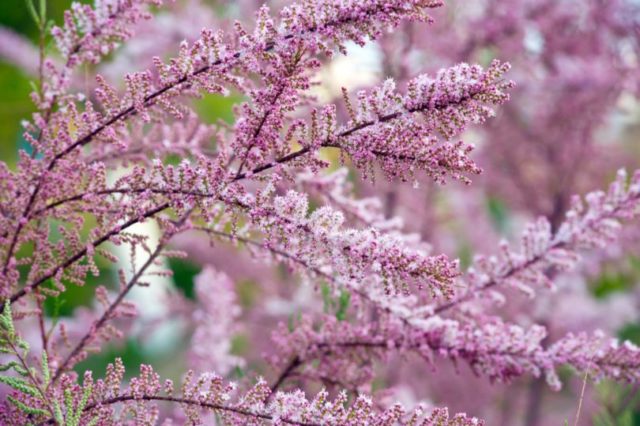

How fast is tamarix growing
Bisernik belongs to shrubs with very fast growth, not least of all this is due to its popularity in landscape design. For a year, tamarix can give an increase of up to 1 m. The roots of the shrub also grow very quickly, they can reach a meter in length even when the height of the plant itself does not exceed a few centimeters.
Advice! Photos of growing and caring for tamarix indicate that it is very convenient to use it in artistic compositions. You do not have to wait for the result for a long time, tamarix very quickly acquires the required dimensions and enters into full decorativeness.
Planting and care at home
It is possible to grow tamarisk not only in the garden, but also indoors. When cultivated at home, the plant also needs to maintain the cultivation characteristics. As a rule, only tamarix seedlings are grown at home, since the size of the bush does not allow it to be constantly cultivated in the house.
It is necessary to plant tamarix at home in early spring, when the period of active vegetation of the plant begins. The seeds are placed in high-quality soil, pre-moistened. The seeds are spread over the surface of the substrate, after which the container is covered with a film until the first shoots appear. As soon as the first shoots appear, the film is removed. Babies need to be regularly sprayed with water. After the appearance of 3 permanent leaves on the plant, the seedlings dive. Planting in open ground is carried out one year after germination.
Tamarix - landing
It is necessary to plant a full-fledged shrub sapling using a special technology. Planting and caring for Tamarix includes the following steps:
- To speed up the rooting process, use root formation stimulants (Kornevin, Heteroauxin - soak the cuttings in them, according to the instructions).
- Prepare the soil on the site - loosen it, add humus.
- Dig a hole, the depth of which corresponds to the length of the roots, and the width is 80-100 cm.
- Pour in some sand, moisten with water, insert the seedling into the hole.
- Sprinkle with earth and tamp, water again.
Wintering tamariks
Despite the fact that tamarix easily tolerates the cold, it is recommended to shelter the plant for the winter. In order to prevent the superficial small roots from freezing in frost, after the flowering of the culture and the ripening of the fruits, a layer of spruce branches or dry foliage is laid around on the ground. A thick layer of peat or a film is also suitable as a cover. After the first dream falls, it is recommended to make a snowdrift around the plant, which will create additional heat.
In the spring, immediately after the extreme cold has been eliminated, tamarix is opened from a snowdrift. The film is removed only after the snow has melted and the temperature has returned to normal. Immediately after the onset of heat, sanitary pruning of the crop is carried out.
Reproduction of tamarix by cuttings
Tamarix cuttings with roots photo
- It is better to carry out the cuttings procedure in the fall, but before the first frost begins.
- Preferably from young, but lignified branches, cut the cuttings 10-15 cm long, place them in a container with warm water and wait for the rudiments of the first roots to appear.
- To accelerate root formation, the first few days, you can keep the cuttings in a solution of heteroauxin or root.
- Then plant in a sand-peat mixture, cover with a cap, keep in a warm place with good lighting.
- It can be planted in the soil in May-June.
- It is imperative that after disembarkation, before the first wintering, the soil around the tamarix is carefully mulched with fallen leaves or peat.
Reproduction
There are several ways to grow a comb maker. Most often, cuttings are used, however, some gardeners prefer to cultivate the plant with seeds, but in this case, no one guarantees the germination of seedlings.
Seeds
The seed obtained from the culture does not retain its vitality well, therefore the method is used only in southern latitudes. In order to get seedlings, the seeds are evenly distributed over the surface of the substrate, and then covered with earth. The seed container is placed on a pallet of water to keep the soil moist at all times. Young seedlings dive as soon as the culture has reached about 10 cm in size. Plants are left in room conditions for the whole winter. With the onset of cold weather, the plants are covered with a film. The following spring, tamarix is transplanted into open ground in the usual way.
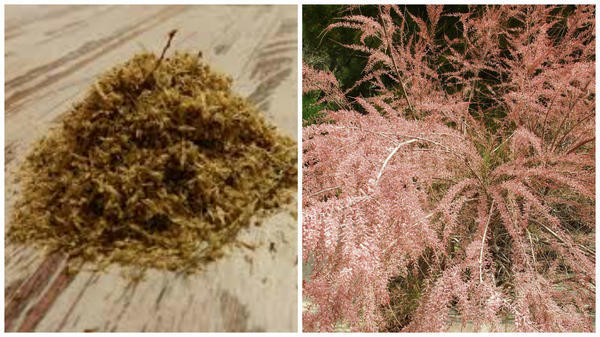

Cuttings
The vegetative breeding method of tamarix is considered the most effective and reliable. In early spring, several brown green twigs, about 7 cm in size, are cut from the mother. Finished cuttings are treated with root, then placed in a light sandy-peat soil. the container is covered in such a way that greenhouse conditions are formed. With the appearance of new leaves on the culture, the plant is considered rooted. However, planting crops in open ground is carried out in May.One year after rooting, the cuttings are placed in a permanent place.
Most popular types
Tamarix has many types. Some of them are grown in temperate climates.
- Branched tamarix very common in front gardens. It is planted like a hedge. The soil is suitable for him and salty. It is resistant to strong winds, but it does not tolerate frost very well. His flowers are pink and purple.
- Tamarix Meyer - a species that grows most often in southern latitudes. It does not tolerate severe frosts, but can live in arid areas in salty soils. It is not recommended to water it often. Its buds are pink.
- Graceful tamarix - a species that is rarely found in flower beds. It has high frost resistance. Its buds are pale pink.
Tamarix is a shrub that is easy to grow in garden plots. He is not whimsical to the conditions, and therefore is popular.
Diseases and pests
With quality care, the comb is practically not exposed to pathologies. Pests also rarely settle on the culture. However, with poor-quality care and the absence of inspection of the bushes, insects can climb onto the tamarisk from neighboring crops and damage the beads.
The most dangerous condition of beads is considered to be a fungus that forms on tamarisk, due to a poor-quality drainage layer, excess water in the ground. It is quite difficult to get rid of pathology, therefore, the culture is planted in advance on the tops of the slopes or in places with arid soil. When fungi appear on the leaves, it is necessary to treat the plant with a fungicide. The basis for the prevention of crop damage is the normalization of irrigation and the creation of a good drainage layer. An annual treatment of the plant with solutions to prevent fungi is also recommended.
Pests and diseases
The ornamental shrub is highly resistant to diseases and pests. Beads are affected by insects only if the infection spreads from neighboring plants. For prevention and treatment, any standard insecticidal solution is suitable - Karbofos, Actellik.
Tamarix can suffer from fungal diseases only if it grows in the shade and on waterlogged soil. To treat rot and any other ailments, you need to remove all affected shoots and treat the shrub with Bordeaux liquid or copper sulfate. After that, it is better to transplant tamarix from the problem area in the sun, otherwise the diseases may return again.
Application
Despite the fact that beads are most often used to decorate gardens and adjacent territories, the plant has a number of useful properties that allow the culture to be used for domestic and medicinal purposes.
At home
Tamarix wood is widely used to create decorative items, toys, baskets. The trunks of mature trees are used to create furniture. It is noted that the furniture obtained from tamarix has a high decorative effect and a long service life.
Beads are often grown near apiaries. The culture is considered a large flower stalk, and due to long flowering, bees manage to create honey from tamarix.
The comb is planted in places with loose and sandy soil. The culture has strengthening properties, as well as unpretentiousness and decorativeness.
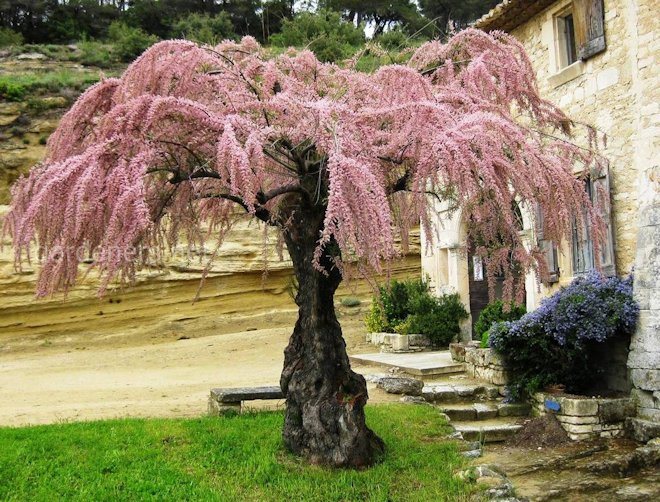

In medicine
No species of tamarix is used as a medicinal plant in traditional medicine. However, it has been proven that tamarix has a number of useful properties that allow the treatment of kidney and endocrine system pathologies. The plant contains substances that stop bleeding, and can also relieve pain.
In folk medicine
The beneficial properties of tamarix and its chemical composition have led to a fairly widespread use of culture in folk medicine.The plant is used for inflammatory pathologies of the stomach and intestines, for rheumatism, for diarrhea. The benefits of culture in the treatment of infertility in women are noted. The vitamins contained in the plant help prevent the development of infectious pathologies, strengthen the immune system. Some tamarisk-based recipes are applied topically and are effective in treating skin rashes.
Recipes
As medicines, on the basis of tamarix, infusions, decoctions, tinctures and tea from tamarix are made. For medicinal purposes, both dry and fresh parts of the plant are used, including twigs, leaves, fruits and bark of a comb.
- for the treatment of gastritis, an infusion of bead flowers is used. For its preparation, the raw material is poured with a glass of boiling water in the amount of one tablespoon. The finished infusion should cool for half an hour. The finished mixture is filtered and consumed in 2 tablespoons before meals.
- To eliminate bleeding, as well as to treat diarrhea, a decoction of tamarisk bark is prepared. A teaspoon of the dry mixture is poured with a glass of boiling water and boiled for 10 minutes. The finished solution is cooled and filtered. After another hour, they begin to take the broth during the day in a small volume.
- To prevent diarrhea, a decoction is obtained from a mixture of the bark and foliage of the comb. The dry mixture is poured with boiling water in a ratio of 1:10, after which it is boiled for half an hour. After that, the container with the broth is carefully closed and allowed to cool in this form. Take the strained infusion inside, three times a day, 1 teaspoon.
- For the therapy of infertility, a decoction is prepared from the fruits of culture. a teaspoon of chopped fruit is poured with a glass of boiling water and put on fire for 20 minutes. Therapy consists in the use of a strained broth 3 times a day for a third of a glass for a month.
- To eliminate rheumatism and arthritis symptoms, tamarix is used in the form of a decoction obtained from the bark of the plant. The broth is prepared according to the following recipe: a tablespoon of the dry mixture is poured into a glass of boiling water, the solution is placed in a water bath for half an hour. After cooling down, the culture is taken as external use, in the form of lotions or rubbing.
- To strengthen the immune system, they drink tea obtained from the branches and flowers of tamarisk. To prepare it, pour a teaspoon of the mixture with a glass of boiling water and insist for 5 minutes. It is taken orally like regular tea.
It is important to understand that tamarisk treatment does not replace the mainstream of traditional medicine, therefore it is used only as an additional one.
How to care for tamarix
Planting becomes only the first stage of tamarix breeding and growing. In order for the shrub to please with a beautiful flowering, it is necessary to carry out competent cultivation and care of the tamarix plant after it.
Watering and feeding schedule
Tamarix is a plant that is quite sensitive to the amount of moisture. The first days after planting in the open air, the seedling must be watered generously - but then the watering is sharply reduced. A bead plant that has successfully taken root in a permanent place should receive moisture due to natural precipitation; additional watering is carried out only during flowering and during a period of severe summer drought. The plant does not tolerate waterlogging of the soil and, in marshy conditions, begins to suffer from root rot and fungi.
As for fertilizing, in the first year tamarix is quite enough fertilizers applied to the soil before planting. For the next year and further, every year, the beads must be supplied with organic fertilizers in early spring and potassium and phosphorus must be added to the soil during flowering.
How to prune tamarix in spring and fall
Tamarix grows very quickly, so you need to prune it every year - not only in the spring, but also in the fall.
- In the spring, pruning is carried out even before the buds begin to swell, so as not to damage the plant.It is necessary to remove first of all all weak and damaged branches. You should also cut off old shoots with small increments - the branches are shortened "by a ring", and just a month later, the beads give young, fast-growing shoots.
- Pruning of tamariks in autumn is carried out mainly for sanitary purposes. During it, you can also remove wilted inflorescences and thin out the crown - excessive thickening of the branches impairs the access of light and oxygen.
From time to time, beads are recommended to be rejuvenated. This is usually done at the beginning of autumn - the shrub is cut almost under the stump, to a strong healthy branch, located close to the base of the bush. Radical pruning stimulates the growth of new shoots, and next year the beads again please the eye with a lush openwork crown and abundant flowering.
How to prepare beads for winter
Different types of tamarix show different resistance to cold. Some plants can easily tolerate extremely low temperatures, others freeze to the level of snow cover. Therefore, it is recommended to cover the beads for the winter in any case.


To protect against cold weather, it is necessary to mulch the soil at the roots of the plant with a dense layer of insulating material. You can also bend and tie the shoots together, fix them in a bent state, and then cover them with spruce branches or a special non-woven material.
Why tamarix does not bloom and what to do
On the site, tamarix is planted precisely for the sake of a beautiful abundant flowering, but sometimes the shrub does not give flowers at all. The flowering of beads and their care are closely related, so usually the life cycle of the plant is disrupted due to errors in cultivation.
- Tamarix grows in the shade. With this arrangement, the shrub can not only stop flowering, but even die altogether, it needs sunlight.
- The bead shoots froze over during the winter - flowers appear on the branches of the last year, and if the latter did not endure the winter well, then flowering can not be expected.
- Tamarix lacks nutrients, if the soil is too scarce, then the shrub simply does not have enough strength for flowering.
- The root of the plant is excessively thickened - the lack of pruning leads to the fact that the bush receives less air and sunlight, respectively, its ability to bloom is reduced.
To restore the health of the shrub, it is necessary to correct the mistakes made during cultivation - to adjust the lighting and soil moisture in the area with tamarix, feed the plant, cut off excess branches. With the onset of cold weather, it is necessary to provide frost protection for young shoots.
Procurement and storage
Almost all aerial parts of beads are used as medicinal raw materials - flowers, bark, foliage and twigs. Harvesting is done at the beginning of the active growing season, in late spring or early summer. The bark is carefully removed from different parts of the tree so as not to damage the culture. Flowers and leaves, as well as twigs, are cut with a sharp knife. After collection, the material is dried using dryers or ovens. Well-ventilated dark rooms are suitable for natural drying. After drying, the plants are stored in crushed form in dry jars, or in paper or cloth bags. The shelf life is no more than two years.
In case of an overdose of the substance, dehydration is noted, as well as the appearance of blood clots. Therefore, decoctions and infusions based on tamarisk are drunk only after consulting a doctor.
Tamarix: breeding features
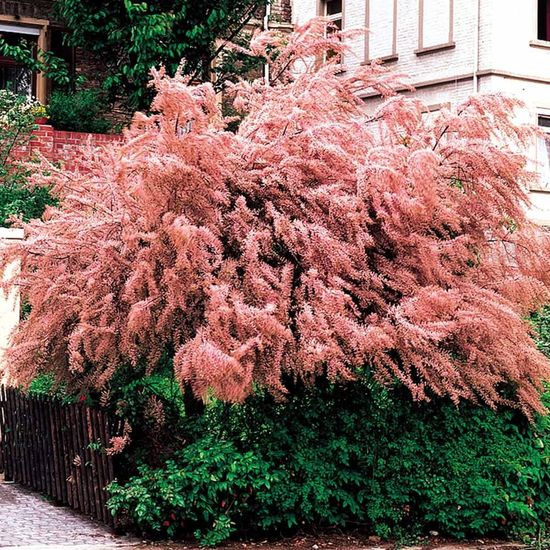

You can breed beads both by cuttings and by means of seeds. But it is more effective to propagate tamarix by cuttings, which are harvested in spring. Their length should be 7-10 cm. Sections of cut cuttings are treated with a working solution based on a growth stimulator and placed in a container with a soil substrate (garden soil and sand in equal proportions).
To create a greenhouse effect, the containers are covered with polyethylene or each stalk with a glass jar.Successful rooting will be indicated by the appearance of green leaves. Fortified cuttings are determined in open terrain, providing them with a reliable shelter for the winter. Planting in a permanent place is carried out in the spring, when the threat of recurrent frosts has passed.
Tamarix is a unique plant with a sufficient degree of hardiness. It does not require special conditions of detention and grows quite normally in the northern regions. The main thing is to provide the shrub with favorable conditions at the initial stage of its development.
Tamarix (Tamarix) is a genus of evergreen plants from the Tamarisk family. These are small trees or shrubs that are found in the wild in Southern Europe, Asia, Africa. The name of the culture comes from the toponym of the Tamm-Reese River, which is located in the Pyrenees. The genus has more than 75 species of plants that prefer to grow in deserts, dunes, salt marshes. Tamariks has many other names - beads, comb, jengil.
This culture has become one of the most widespread for landscape decoration. It is ideal for a sunny garden. The tree is unpretentious to care for and is quite drought resistant. Moreover, it has a high decorative effect.
Tamarix in landscape design
Tamarisk is considered to be one of the most ornamental trees with evergreen leaves. The plant is widely used among ornamental crops. Plants are grown as single crops and among other plantings. The advantage of planting beads is the possibility of cultivating it on slopes and in sandstones. The plant will not only decorate any area, but also strengthen it.
The combers are often found in the alpine slides and among the parks. The plant is grown more often with low-growing shrubs, serves as a background for other crops. Low-growing crops go well with lavenders, dahlias, Chinese roses. The plant looks effectively as landscaping of alleys and park roads.
Growing tamarix: the secrets of care and proper planting
When you first see a tamarix in bloom, the only word that comes to mind to describe this phenomenon is grace. A small shrub with small scaly leaves and numerous shoots bent to the ground under profusely blooming white or pink racemose inflorescences looks elegantly. And when the flowers have not yet blossomed, it seems that the tree is covered with beads. The picture is really unforgettable.
Tamarix (lat. Tamarix) - a genus of trees or shrubs. Its other names are comb, bead.
The plant is native to the steppes and deserts of southern Europe, Africa and Asia.
In culture, the comb is used for several purposes: to strengthen saline soils and sands, for landscaping in ornamental gardening, for the treatment of certain diseases in folk medicine. Tamarix wood is used as fuel; crafts, baskets, and furniture are made from it. And in the mountains of Central Asia, the leaves of the bush are eaten by camels. The comb grower is loved by beekeepers, because he is an excellent honey plant.
If you want such a miracle of the plant world as tamarix to settle in your suburban area or in front of a window, you need to know the features of its planting and care.
Tamarix varieties
Winter-hardy varieties are especially popular. They are often planted in the middle lane.
| View | Description Height (m) | Features of the |
| Branched (branched) | The crown is vertical. At the ends of the branches, green shoots with subulate leaves 1.5 cm long. Up to 2. | Inflorescences are pink racemose. Blooms June-September. |
| Loose | Has a spreading crown. The leaf blades are characterized by an ovoid shape. The branches can be green and gray. Flowering lasts for 2 months. Undemanding to the soil cover. |
Up to 5.
Reaches 10.
Not higher than 4.
Until 3.


The views are arranged sequentially, as in the table.

